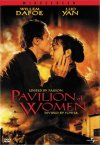BUY THE DVD:
|


|
|
|
SYNOPSIS:
| |
an american missionary falls in love with a high-born chinese woman, who is already married.
|
|
|
MOVIE FACT:
| |
one of the first joint us-china film productions.
|
|
|
RATING:
|

one out of four possible stars
|
|
|
|
While the costumes, set decorations, and actors in Pavilion of Women are all beautiful, the drama and story of the film fall flat for most of its running time. The story, based on a novel by Pearl S. Buck, concerns a forty year old Chinese woman who buys her husband a second wife and later forms a relationship with an American missionary. The film explores many of the conflicts between Chinese and Americans in 1930's China and the problems the advent of Communism gave the people living there. While the era gives the film a good subject to cover, the characters that populate this story are rather flat.
The first misstep by the production was to allow the Chinese characters to speak English, as if it was their first language. Some of the Chinese characters actually speak American accented English. While this is a common occurrence in American productions that take place in foreign countries, making the film entirely in English lessens its reality. And what adds to the lack of authenticity is the lifelessness of every one of the characters. Though the father, played by Shek Sau , has a strange amount of goofiness about his character, he’s probably the most interesting and outspoken character of the film.
Which means that the two leading roles, a Catholic missionary priest, played by Willem Dafoe, and the Chinese wife he falls in love with, played by Yan Luo, don’t have a lot of enthusiasm throughout the picture. Perhaps it was the intention of the filmmakers to create a movie where the emotion present in the characters was much more subdued than in normal life. Or perhaps Chinese living in the 1930’s really were that low-key. Whatever the reason, the characters and by extension, the performances, were all very lackluster.
While there are short moments of conflict in the film, there is not enough tension between the characters to sustain an interesting narrative. The vivid arguments and psychological dealings present in such a movie as Raise The Red Lantern have the ability to keep an audience interested for the duration of a movie, and the addition of interesting art direction, music, and cinematography, can make for an enthralling movie. But Pavilion Of Women never becomes an absorbing experience. In fact, the first sixty minutes of the film pass by very slowly and halfway into the film it is nearly impossible to tell from which perspective the movie is being told. The question of which character the film focuses on becomes a problem after the first act, as the scenes pass by rather languidly and no progression of story really occurs.
Putting aside the lack of character development for the moment, the other ingredients of the film, like the music for example, don’t make that much of an influence either. While the music is at times beautiful, it’s not something that will cause audience members to rush out and buy the soundtrack after viewing the movie. And while the cinematography is competent, the small sets (perhaps the result of a small budget) don’t give the picture the epic touch it needs for the era to really come alive.
And that is really what the picture is lacking: a sense of vitality in the characters, story, and scenery. Certainly, there were moments of the film that were beautiful, and sometimes Willem Dafoe was able to make his character spark a little, but like the water off a windless ocean, this film is much too smooth in its presentation to really affect the audience emotionally. And because this film isn’t a documentary on The History Channel and because it’s entirely a work of fiction, the fact that it isn’t a gripping, poignant experience for its audience makes it more of a trial than an enjoyment to sit through.
The novel this movie was based on had widespread appeal in both the Eastern and Western worlds. Pearl S. Buck’s stories easily crossed over to both societies when they were first published and still enjoy a duel existence in on both sides of the Pacific. But the word that would describe the overall production of Pavilion Of Women best would probably be mediocre. From the characters to the story to the music, nothing in this film really stands out. It would be very hard to recommend this film on any one merit, as the high points of the production don’t really reach that high. It’s hard to ascertain the amount of effort placed into the film as no single element stands out as fantastic.
Review by Kelsey Wyatt.
| |
|